
The Medici: Portraits and Politics, 1512–1570
Between 1512 and 1570, Florence underwent dramatic political transformations. As citizens jockeyed for prominence, portraits became an essential means not only of recording a likeness but also of conveying a sitter’s character, social position, and cultural ambitions. This fascinating book explores the ways that painters (including Jacopo Pontormo, Agnolo Bronzino, and Francesco Salviati), sculptors (such as Benvenuto Cellini), and artists in other media endowed their works with an erudite and self-consciously stylish character that made Florentine portraiture distinctive.
The Medici family had ruled Florence without interruption between 1434 and 1494. Following their return to power in 1512, Cosimo I de’ Medici, who became the second Duke of Florence in 1537, demonstrated a particularly shrewd ability to wield culture as a political tool in order to transform Florence into a dynastic duchy and give Florentine art the central position it has held ever since. Featuring more than ninety remarkable paintings, sculptures, works on paper, and medals, this volume is written by a team of leading international authors and presents a sweeping, penetrating exploration of a crucial and vibrant period in Italian art.
Met Art in Publication
You May Also Like
Press the down key to skip to the last item.
Citation
Christiansen, Keith, and Carlo Falciani. 2021. The Medici: Portraits and Politics, 1512-1570 [Exhibition at the Metropolitan Museum of Art, New York, June 26-October 11, 2021]. New York, NY: The Metropolitan Museum of Art.





